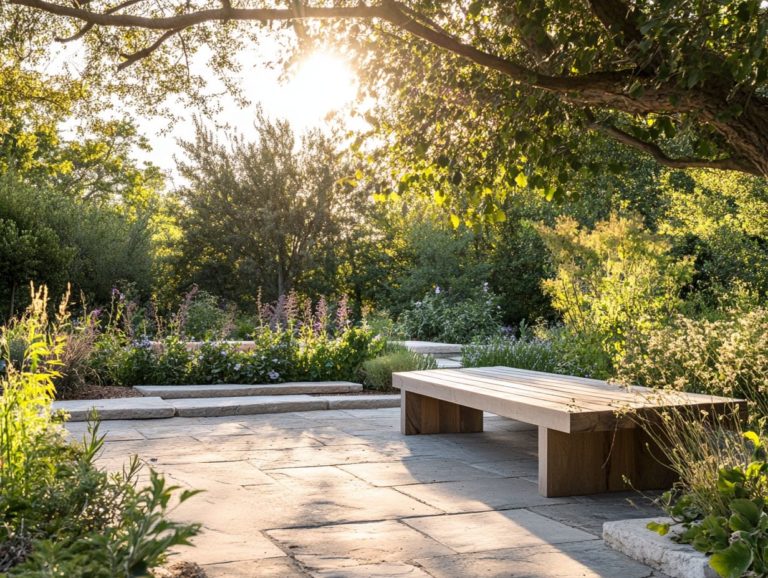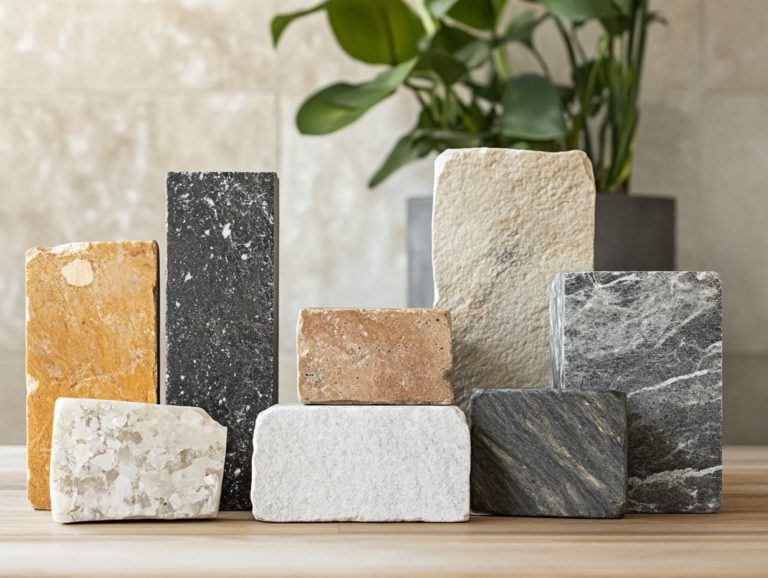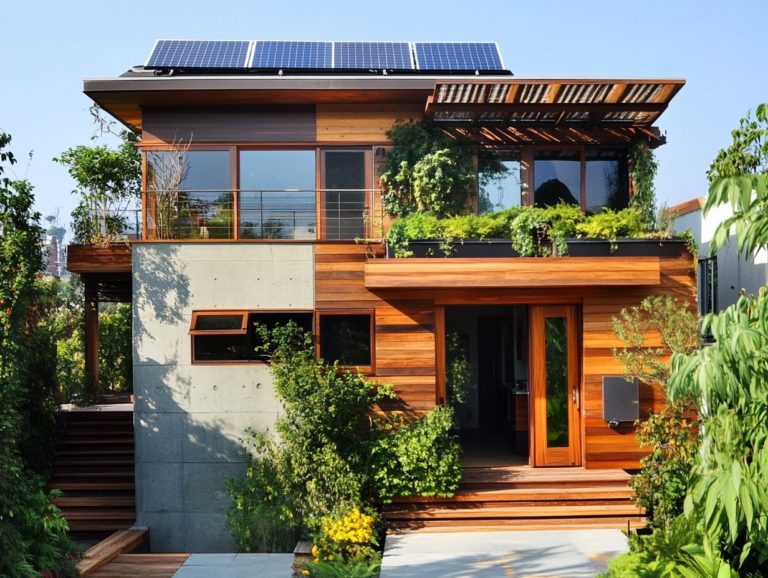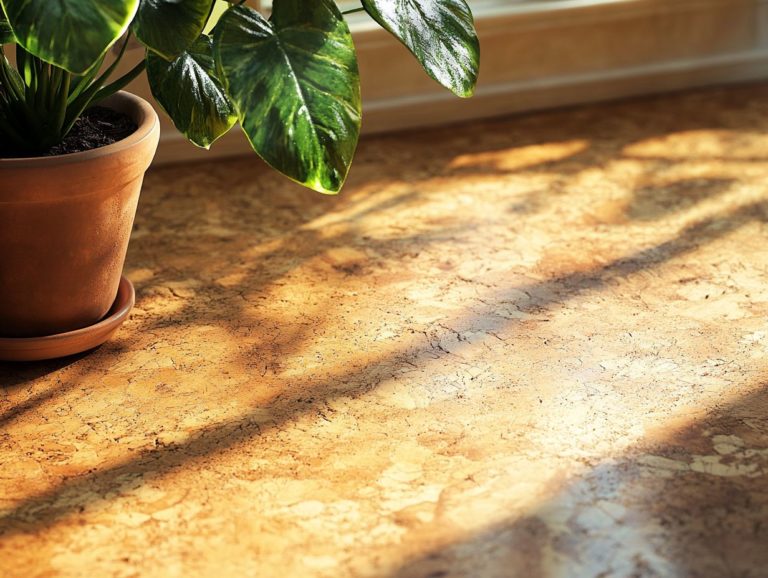The Benefits of Living Walls in Homes
Living walls, also known as vertical gardens or green walls, are not just aesthetic additions; they offer a multitude of benefits that enhance both your home and the surrounding environment.
This exploration delves into the advantages of integrating living walls into your space, from remarkable improvements in air quality to uplifts in mental well-being and potential cost savings.
You’ll discover the various types of living walls and receive a comprehensive step-by-step guide to creating your own. You’ll also learn essential maintenance tips to ensure your green oasis flourishes.
Get ready to transform your space into a lively, eco-friendly haven!
Contents
Key Takeaways:
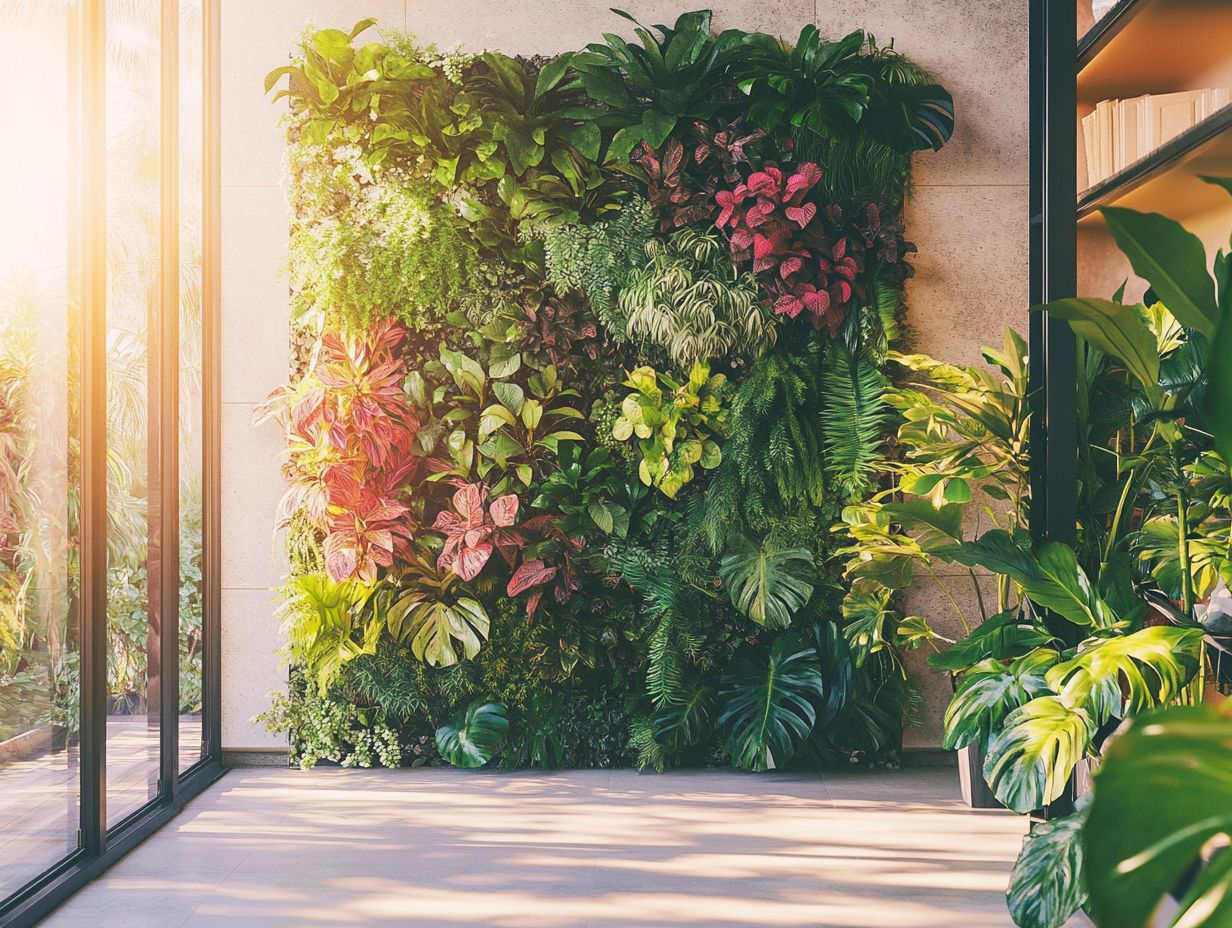
Living walls provide numerous environmental benefits, such as improving air quality and reducing energy consumption, making them a sustainable and eco-friendly addition to any home.
These installations also offer health and well-being benefits, including reducing stress levels and improving overall mental health and productivity.
Not only are living walls aesthetically pleasing, but they can also provide financial benefits by increasing property value and reducing energy costs, making them a valuable investment for homeowners.
Discover the Magic of Living Walls!
Living walls are innovative structures that seamlessly integrate vegetation into their design, allowing plants to thrive even in bustling urban settings.
These eco-friendly marvels offer a wealth of benefits, such as purifying the air, enhancing biodiversity, and boosting your well-being through a touch of nature.
By incorporating living walls into both residential and commercial spaces, you enhance both homes and businesses while making a meaningful contribution to sustainable design practices.
As urban greening becomes increasingly vital, living walls serve as your essential link to nature, acting like natural air purifiers and enhancing your indoor environment.
Crafted from modular systems or pre-planted panels, these walls can support a diverse array of plant species, from vibrant flowering perennials to lush ferns and even edible plants like herbs.
Their versatility opens the door to countless applications, including public spaces, office buildings, and schools, where they create a tranquil atmosphere.
Don’t miss out on how these green installations are transforming urban living! Living walls play a crucial role in mitigating urban heat, enhancing building insulation, and reducing stormwater runoff.
As the trend of integrating green infrastructure grows, living walls are becoming symbols of sustainable urban development, harmonizing architecture with nature and promoting your eco-conscious lifestyle.
Benefits of Living Walls
Living walls present a wealth of advantages that touch on environmental, health, and financial dimensions, positioning them as an exceptional choice for urban environments.
They play a vital role in enhancing air quality, acting as natural air filters that cleanse the atmosphere of pollutants like carbon dioxide and volatile organic compounds (VOCs).
Infusing greenery into urban landscapes fosters biodiversity, elevates emotional well-being, and boosts productivity in workplaces. This makes them a critical element in contemporary sustainable design.
Environmental Benefits
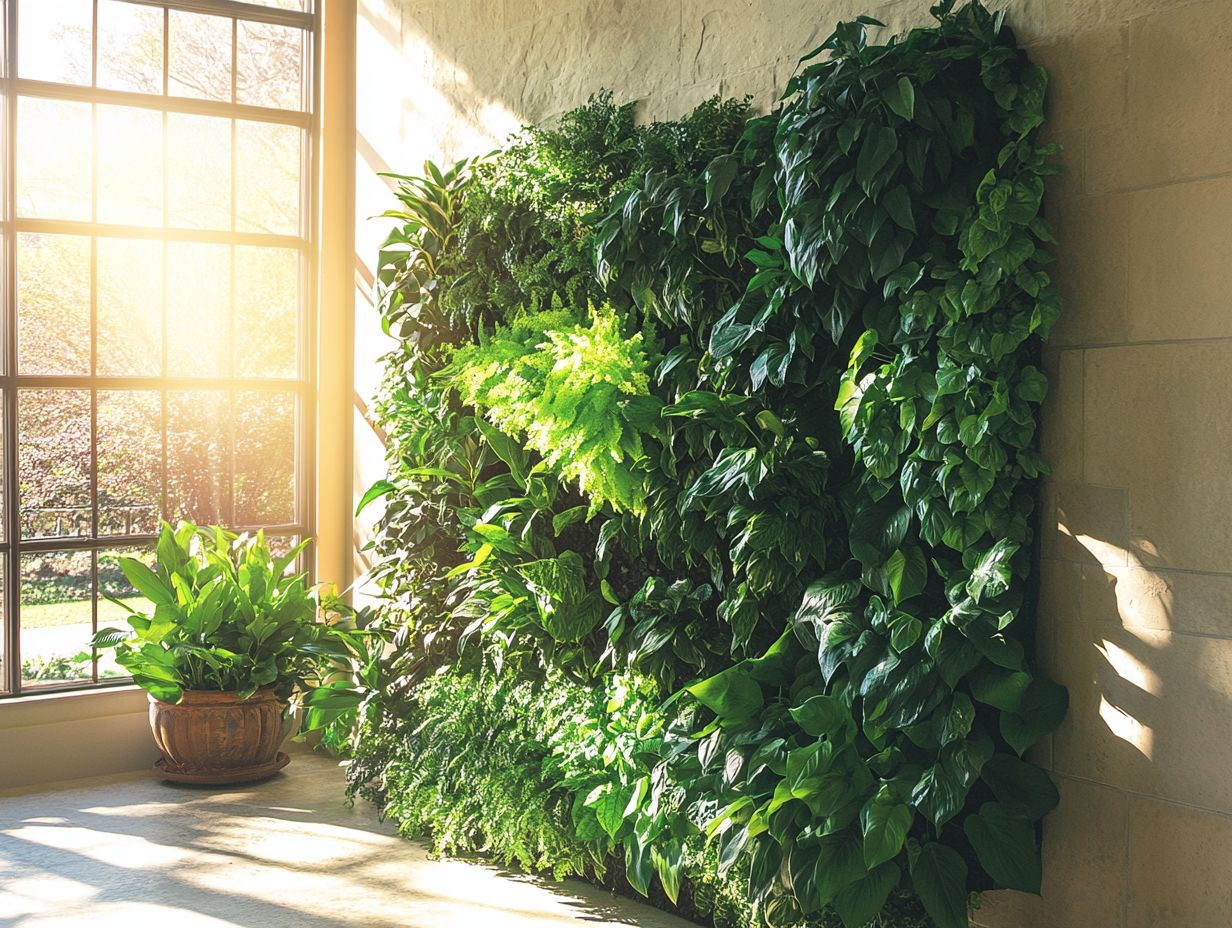
The environmental benefits of living walls are impressive. They play a crucial role in reducing pollution and enhancing urban biodiversity. These vertical gardens act as natural air filters, improving air quality by absorbing harmful pollutants like carbon monoxide and carbon dioxide. They also provide habitats for various species.
By integrating green infrastructure into your surroundings, you can optimize energy efficiency in buildings and assist with temperature control. This ultimately supports urban sustainability.
Living walls can lower temperatures by up to five degrees, which helps fight climate change. This is an essential strategy to counter the urban heat island effect (a phenomenon where urban areas become significantly warmer than their rural surroundings due to human activities). Studies have shown that these installations boost local biodiversity by providing crucial habitats for birds, insects, and other wildlife, all vital for maintaining ecological balance.
Living walls also help manage stormwater by absorbing rainwater, thereby reducing runoff and erosion. In urban settings, they elevate aesthetic appeal and play a significant role in creating sustainable cities, enhancing the quality of life for residents and fostering a healthier ecosystem.
Health and Wellbeing Benefits
Living walls offer remarkable health and well-being benefits. They significantly enhance your mental health and emotional wellness. Research indicates that connecting with nature can improve cognitive function, reduce stress levels, and increase emotional resilience.
When included in workplaces, living walls boost employee wellness and productivity, creating nurturing environments that inspire creativity and overall well-being.
Several studies, including one from the University of Exeter, highlight that adding greenery, such as living walls, can diminish stress and improve overall job satisfaction among employees.
A compelling example comes from a New York City tech firm, where the installation of a living wall resulted in a 15% increase in productivity. Employees reported feeling more energized and focused, illustrating a clear link between biophilic design elements and a motivated workforce.
These findings emphasize the transformative impact of living walls in cultivating healthier and more engaging workspaces.
Financial Benefits
Investing in living walls can significantly boost your finances! Properties adorned with green space often enjoy higher market appeal, translating into increased selling prices or rental rates.
Living walls enhance workplace productivity and lower energy costs through improved insulation and efficiency.
For example, buildings featuring living walls can sell for up to 15% more than comparable properties without them. This surge in market value benefits you as an investor and cultivates a sustainable business model that attracts eco-conscious tenants.
In terms of energy savings, you might see consumption drop by as much as 30% in spaces incorporating these features, thanks to their natural insulation properties. This reduction cuts operating costs for your business and contributes to a smaller carbon footprint.
In essence, living walls present a compelling blend of financial viability and environmental responsibility, making them a strategic asset for your property portfolio.
Types of Living Walls
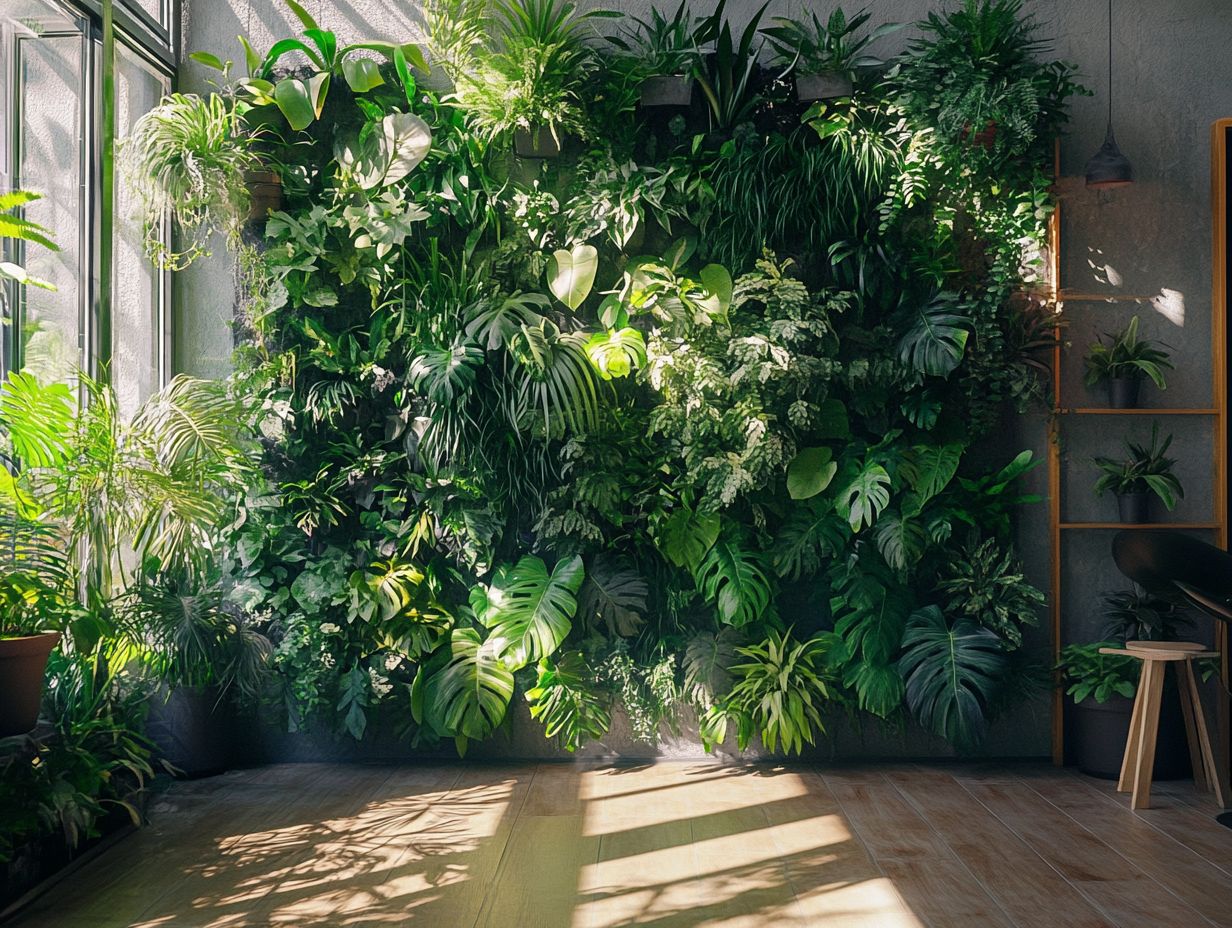
There are two main types of living walls: vertical gardens and green walls. Each presents distinct advantages and applications across diverse environments.
Vertical gardens showcase an array of plants arranged harmoniously, delivering aesthetic charm that enhances urban landscapes.
In contrast, green walls focus on specific plant types that thrive in particular climates, making them ideal for both residential homes and commercial spaces eager to adopt eco-friendly solutions.
Vertical Gardens
Vertical gardens are a striking form of living wall solutions. They allow you to incorporate a variety of plants that create breathtaking visuals while enhancing your indoor connection to nature, especially in urban settings.
Whether you’re looking to beautify your home or elevate a commercial space, these gardens offer an eco-friendly answer to the challenges of modern urban life.
Choosing the right plants is essential. Think ferns, succulents, and various herbs that thrive in different light conditions, making them perfect for vertical arrangements.
You’ll find an array of installation methods. These include pre-made kits featuring pre-planted panels and free-standing structures that accommodate growth on multiple surfaces.
Maintenance is key. Regular watering and occasional pruning keep your green walls healthy and vibrant. In cities like Sydney, you can witness remarkable vertical gardens, such as the iconic One Central Park. These not only enhance aesthetic appeal but also contribute to improved air quality.
Green Walls
Green walls are sophisticated structures designed to weave plant life into architectural frameworks. They champion urban greening and sustainable design practices.
These walls do more than beautify; they enhance biodiversity, mitigate pollution, and add striking visual flair to city landscapes.
In contrast to vertical gardens, which feature dynamic elements and a mix of plant varieties for aesthetic appeal, green walls operate on a more structured system. Plants are embedded into a robust framework, enhancing their functionality.
This design provides insulation and reduces noise pollution, significantly improving air quality.
The capacity of green walls to nurture diverse ecosystems is vividly illustrated in projects like the iconic Bosco Verticale in Milan and the Kew Gardens Urban Greening project in London. These examples showcase how greenery can transform urban environments and create thriving wildlife habitats.
Through such initiatives, green walls elevate the aesthetic quality of surroundings and play a vital role in addressing pressing climate challenges.
How to Create a Living Wall in Your Home
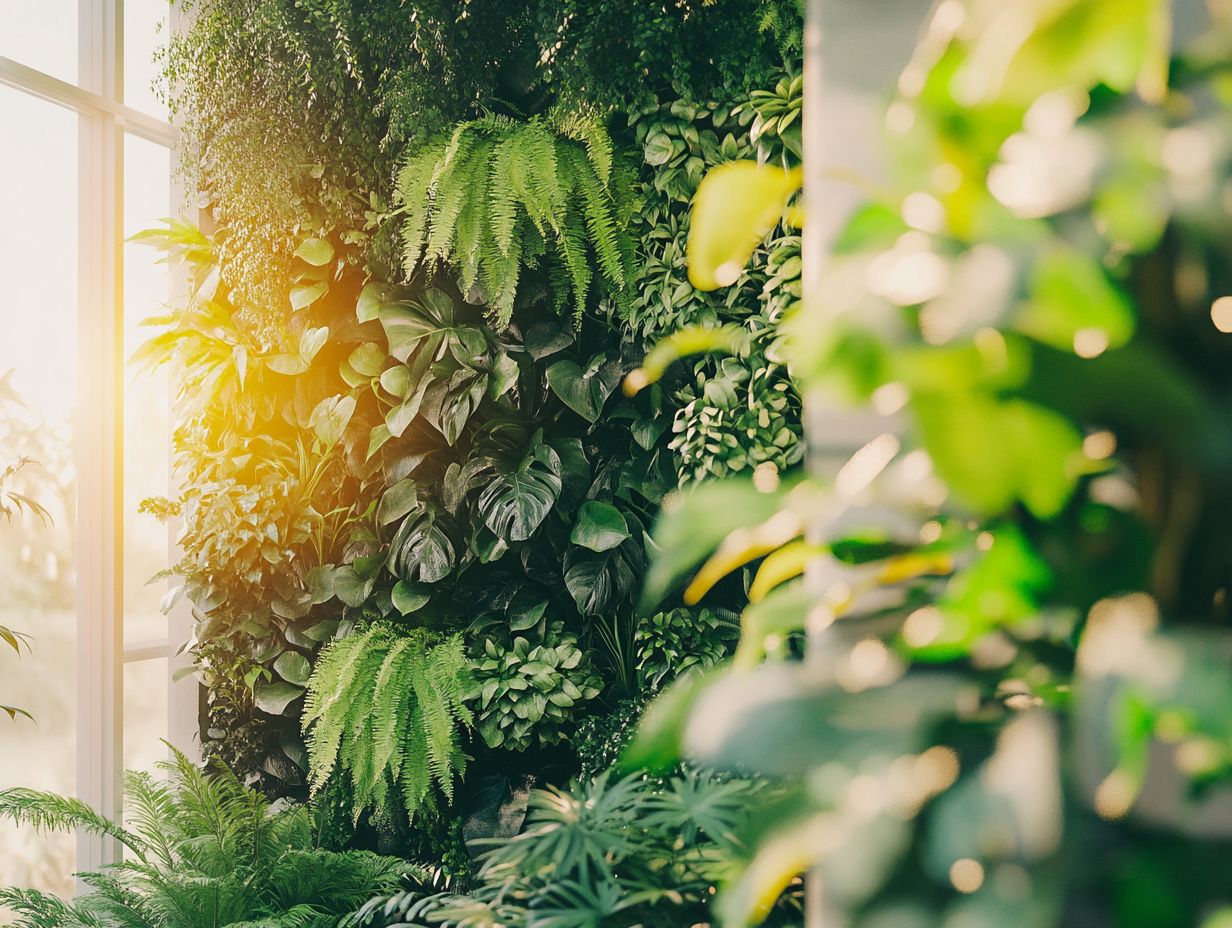
Transform your home instantly with a stunning living wall! This enriching journey not only enhances your indoor space but also champions eco-friendly living.
By adhering to a carefully crafted step-by-step guide, you can seamlessly integrate living wall solutions that elevate air quality and infuse aesthetic elegance into your residence.
Step-by-Step Guide
To create a stunning living wall, start by selecting the perfect location that receives adequate sunlight and has convenient access to water.
Next, choose the right materials for your installation. Consider using materials like modular planters, felt pockets, or a trellis system for solid plant support.
This comprehensive guide will walk you through the installation process and plant selection. Ongoing maintenance is also essential for your indoor garden to truly flourish.
Once you’ve pinpointed the ideal spot, ensure the wall surface is clean and free from pollutants.
In terms of plant selection, pay attention to their light and water needs to cultivate a harmonious ecosystem. After everything is set up, layering the soil correctly and ensuring proper drainage are vital for plant health.
For ongoing care, regularly check moisture levels, prune when necessary, and keep an eye out for pests. This diligent attention will help your living wall thrive and enliven your space for years to come.
Caring for Your Living Wall
Caring for your living wall is crucial for preserving its health and visual appeal. It demands your regular attention and a keen understanding of your indoor plants’ needs.
By adopting the right watering, pruning, and fertilization techniques, you can ensure your living wall flourishes, continuously delivering its myriad benefits for years to come.
Start your living wall project today!
Maintenance Tips
Your living wall can thrive if you act swiftly! Effective maintenance requires a thoughtful blend of regular watering, pruning, and vigilant pest monitoring. Establishing a consistent routine will elevate the aesthetic appeal and extend the life of your living wall.
To start, ensure you water your living wall consistently, preferably during the early morning or late afternoon to reduce evaporation. Schedule pruning during the growing season, focusing on overgrown areas to encourage healthier growth.
Be vigilant about common pests like aphids and spider mites; catching their early signs is key to managing infestations effectively. Use tools like moisture meters (devices that measure the water content in the soil) and pruning shears to streamline your gardening efforts.
Use resources like gardening apps and local workshops to gain valuable insights and support, helping you maintain a vibrant indoor ecosystem.
Frequently Asked Questions
What are living walls in homes?
Living walls, also known as green walls or vertical gardens, are installations of plants that cover the surface of a building’s interior or exterior walls. These walls provide a natural and eco-friendly way to add greenery to a home.
What are the benefits of having living walls in homes?
There are numerous benefits of having living walls in homes, including:
- Improved air quality
- Noise reduction
- Energy efficiency
- Aesthetic appeal
These walls also promote a sense of relaxation and well-being.
How do living walls improve air quality?
Living walls act as natural air purifiers, filtering out harmful toxins and pollutants from the air. The plants absorb carbon dioxide and release oxygen, creating a healthier and fresher indoor environment.
Do living walls require a lot of maintenance?
Contrary to popular belief, living walls do not require a lot of maintenance. Most installations come with an irrigation system that automatically waters the plants, and the plants used are typically low-maintenance and hardy.
Can living walls save energy in homes?
Yes, living walls can help save energy by acting as natural insulation. They provide an extra layer of protection for the building, reducing the need for heating and cooling and thus lowering energy costs.
What types of plants are suitable for living walls in homes?
Various types of plants can thrive in living walls, including ferns, succulents, herbs, and moss. It is essential to choose plants suited for the amount of sunlight and humidity in the installation area.
Start your living wall journey today and transform your space!


